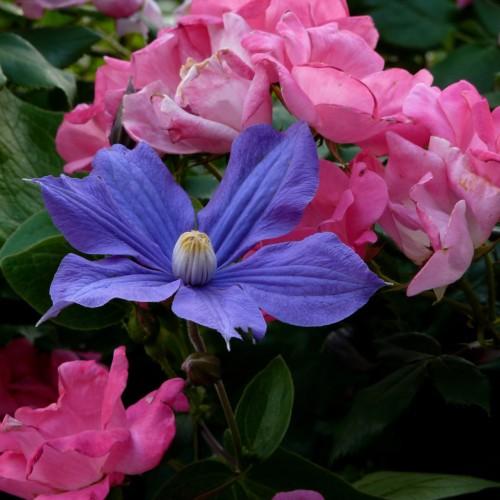
clematis
Clematis durandii
Cycle:
Perennial
Watering:
Average
Hardiness Zone:
5 - 9
Flowers:
Flowers
Sun:
Full sun,part shade
Leaf:
Yes
Growth Rate:
Low
Maintenance:
Moderate
Salt Tolerant:
Yes
Care Level:
Medium
watering
Clematis durandii should be watered regularly throughout the growing season. Water the plant deeply at least once a week, providing 1 to 2 inches of water. To ensure an adequate amount of water is reaching the roots, aim to saturate the soil about 8-10 inches deep. Be sure to avoid waterlogging, though, as this can cause excessive stem and root rot. During extreme heat waves, Clematis durandii may require additional water for optimal health. Water the plant more frequently if dry conditions persist. In the winter months, when the plant is dormant, watering can be reduced to once every 2 weeks.
sunlight
Clematis durandii, commonly known as stonemason's clematis, needs 6-7 hours of direct sunlight in order to grow and flourish. To be in optimum health, it should get at least 4 hours of sunlight each day, with 2-3 hours of full direct sun and the remaining day in the morning and afternoon or in filtered light. However, if placed in a very sunny spot, Clematis durandii should be acclimated to the light by providing partial shade for a few days, as too much direct sunlight can harm it. This species prefers full sun to partial shade, with some afternoon shade in areas with intense summer sun. Temperatures should not go below 45 degrees Fahrenheit for it to grow properly, so it should be sheltered during colder seasons.
pruning
Clematis (Clematis durandii) should be pruned twice a year for optimal growth and health. During the first pruning in early spring, remove any dead, damaged, or weak stems. Cut back the other stems to a length of 18-24 inches or to the desired shape. If desired, leave 4-6 buds on the end of each stem. During the second pruning in late summer, reduce the length of each stem by a third or to the desired shape. This pruning encourages more vigorous flowering in the next season. If desired, leave 3-4 buds on the end of each stem.
Season
Hardiness Map
FAQ
Can Clematis plants grow in pots?
Yes, Clematis plants can definitely be grown in pots. When planting a Clematis in a pot make sure to use a larger size pot with drainage holes and fill it with a mix of well-draining potting soil and compost. Ensure to keep the root area cool and the pot in a sunny location while providing regular water and fertilization. Check the plant almost daily to make sure it is not becoming too dry. Clematis can do well in a pot and with the right care and conditions, they will thrive.
Are Clematis plants self-pollinating?
No, clematis plants are not self-pollinating. Clematis plants need pollinators such as bees, butterflies, moths and other insects to transfer pollen from the male anthers to the female stigma of the flower in order to produce viable seed. Pollination must also occur within relatively close proximity of the same species in order to create viable hybrid plants.
Can Clematis plants be grown as a houseplant?
Yes, Clematis plants can be grown as a houseplant. It is best to grow them in a pot with full sun and a soil that is rich in organic material and retains moisture. When potting the plant, place a stake or trellis next to the pot so that the vine can climb when it begins to grow. Be sure to water your Clematis plant regularly to keep it healthy and growing. Additionally, keep an eye out for pests and treat with natural insecticides as necessary.
Could Clematis plants survive in a colder climate?
Yes, Clematis plants can survive in colder climates with proper preparation. If planted in the fall, proper mulching should be done to protect the roots from cold temperatures. If planted in the spring, they should be watered frequently to help them adjust to the cooler temperatures more quickly. If temperatures drop below -20°C ( -4°F), additional measures may need to be taken such as the application of protective wraps and thermal insulation. Additionally, plants in exposed areas should be protected from the wind to prevent excessive dehydration. With the right measures in place, Clematis plants can easily survive in colder climates.
Could Clematis plants be grown in a greenhouse?
Yes, clematis plants can be grown in a greenhouse. Due to their vine-like growth habit and tropical native origins, clematis plants thrive in the moist and warm environment of a greenhouse. Clematis are generally grown from cuttings or from dividing existing plants, and benefit from regular pruning and fertilizing. They will also enjoy the indirect light of a greenhouse and the protection from strong winds and temperatures that the humidity and contained environment provides.
